Weekly Current Affairs (15th to 21st July 2024) Part - 2 | General Test Preparation for CUET UG - CUET Commerce PDF Download
GS3/Economy
China Plus One
Why in news?
- India has the opportunity to capitalize on the strategy and attract global manufacturing investments. While China's exports remain strong, India's large domestic market, low-cost talent, and potential for growth make it an appealing alternative.
What is the China+1 Strategy?
About:
- It refers to the global trend where companies diversify their manufacturing and supply chains by establishing operations in countries other than China. This approach aims to mitigate risks associated with over-reliance on a single country, especially in light of geopolitical tensions and supply chain disruptions.
China's Dominance in Global Supply Chains
- China has been the center of global supply chains for the past few decades, earning the title of "World's Factory". This was due to favorable factors of production and a strong business ecosystem.
Shift to China in the 1990s
- In the 1990s, large manufacturing entities from the US and Europe shifted their production to China, attracted by the low manufacturing costs and access to a vast domestic market.
Evolution of the China+1 Strategy
- The confluence of factors, including China's zero-Covid policy, supply chain disruptions, high freight rates, and longer lead times, has led many global companies to adopt a "China-Plus-One" strategy. This involves exploring alternative manufacturing locations in other developing Asian countries, such as India, Vietnam, Thailand, Bangladesh, and Malaysia, to diversify their supply chain dependencies.
What are the Opportunities for India to Attract Foreign Investment?
- Demographic Dividend and Consumption Power: India's youthful demographic, with 28.4% of the population under 30 in 2023 according to the World Bank's data, compared to China's 20.4%, is driving the workforce and consumer market. This boosts consumption, savings, and investments, positioning India as a potential multi-trillion dollar economy and attractive market for global companies.
- Cost Competitiveness and Infrastructure Advantage: India's lower labor and capital costs compared to competitors like Vietnam make its production sector highly competitive. A 2023 study by Deloitte stated that India's average manufacturing wage is 47% lower than China's. Additionally, the government's heavy investment in infrastructure through the National Infrastructure Pipeline (NIP) reduces manufacturing costs and improves logistics by 20%, further enhancing India's attractiveness.
- Business Environment and Policy Initiatives: Recent policy interventions like the Production Linked Incentive (PLI) scheme, tax reforms, and relaxed FDI norms have created a conducive business environment. Make in India initiative, coupled with efforts to promote ease of doing business, is attracting foreign investments.
- Digital Skilling and Technological Edge: As of January 2024, India has 870 million internet users, representing 61% of its population. This, combined with access to global tech giants like Google and Facebook, unavailable in China, gives Indian youth a digital advantage.
Which Sectors will Benefit from the China+1 Strategy in India?
- Information Technology/Information Technology Enabled Services (IT/ITeS): In a 2024 NASSCOM report, India is recognized as a key player in IT services exports, bolstered by initiatives like [specific initiative], which aims to establish the country as a manufacturing hub for IT hardware. This effort has attracted major global technology firms.
- Pharmaceuticals: India's pharmaceutical industry, valued at Rs 3.5 lakh crore in 2024, is the world's third-largest by volume. India has emerged as a "pharmacy of the world," supplying nearly 70% of WHO's vaccine needs and offering 33% lower manufacturing costs than the US.
- Metals and Steel: India's rich natural resources and the PLI scheme for specialty steel, expected to attract Rs 40,000 crore in investments by 2029, position it as a major steel exporter. China's withdrawal of export rebates and imposition of duties on processed steel products enhance India's attractiveness.
What is India's Performance in the C+1 Landscape?
- Import Growth: India's imports from Western countries have shown the second-highest growth among analyzed countries, with a compound annual growth rate (CAGR) of 6.3% from 2014 to 2023. Vietnam and Thailand have outperformed India, with a CAGR of 12.4% in imports by the US, UK, and EU.
Business Perception
- Despite having abundant resources and strategic planning, India has struggled to create a positive impression among businesses relocating from China. Vietnam and Thailand have emerged as more attractive destinations.
Tariff Rates
- India's higher tariff rates, averaging 14.7% for non-agricultural products, have deterred Western investors. This is the highest among the countries analyzed. The inverted duty structure in India, where taxes on imported raw materials are higher than those on final products, reduces the competitiveness of Indian exports.
Promising Future Prospects
- As per analysis, India has emerged as the most favored destination for companies planning to relocate production or invest in new facilities in Asia, with 28 companies showing interest, compared to 23 for Vietnam. Notably, a significant portion of these interested firms (8 out of 28) are from the electronics sector, an area where India has previously lagged behind Vietnam.
What are the Factors Hindering India's Competitiveness?
- Ease of Doing Business: Regulatory environment is complex, characterized by bureaucratic hurdles and inconsistent policy implementation, which deter both domestic and foreign investors.
- Manufacturing Competitiveness: India faces significant challenges in manufacturing competitiveness due to high input costs, inadequate infrastructure, and a shortage of skilled labor. The CME Group's ranking highlights this issue, placing India behind several Southeast Asian nations.
- Infrastructure Deficiencies: Poor transportation, logistics, and energy infrastructure increase operational costs and reduce business efficiency.
- Labour Market Rigidities: Restrictive labor laws hinder flexibility and job creation, particularly in the organized sector.
Way Forward
- Targeted Incentives and Subsidies: India should offer attractive incentives and subsidies, particularly in sectors like electronics, automotive, and pharmaceuticals, to set up manufacturing facilities in India, including tax benefits, land subsidies, and infrastructure support.
- Improve Ease of Doing Business: The focus should be made on streamlining regulatory processes, reducing bureaucratic hurdles, simplifying labor laws, land acquisition procedures, and environmental clearances to enhance the overall ease of doing business in India.
- Develop Specialized Industrial Clusters: There is a need to create dedicated industrial clusters or manufacturing hubs for specific sectors with world-class infrastructure and support services, including plug-and-play facilities, common testing and certification centers, and shared logistics infrastructure.
- Invest in Skill Development: India should also focus on strengthening vocational training programs and collaborate with industry to develop a skilled workforce aligned with the needs of the manufacturing sector, promote STEM, and upskill the existing workforce to meet the demands of high-tech manufacturing.
Conclusion
The C+1 opportunity presents a crucial chance for India to address its longstanding manufacturing sector challenges and emerge as a global manufacturing powerhouse. By addressing the key bottlenecks and implementing a comprehensive strategy, India can leverage this trend to drive sustainable economic growth and job creation. The time is ripe for India to seize the C+1 opportunity and cement its position as a preferred manufacturing destination.
Mains Question:
What is the China Plus One Strategy? Discuss the challenges and opportunities for India to fully utilize this strategy.
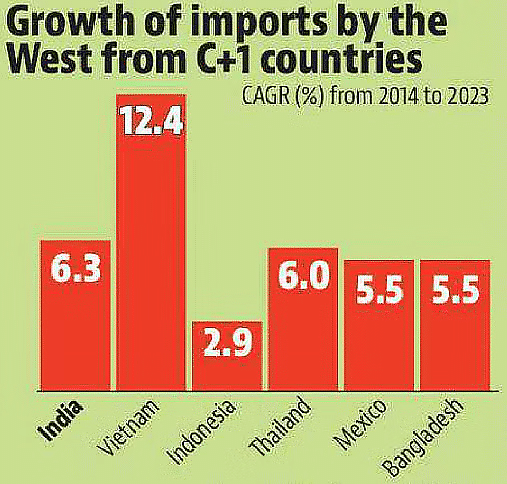

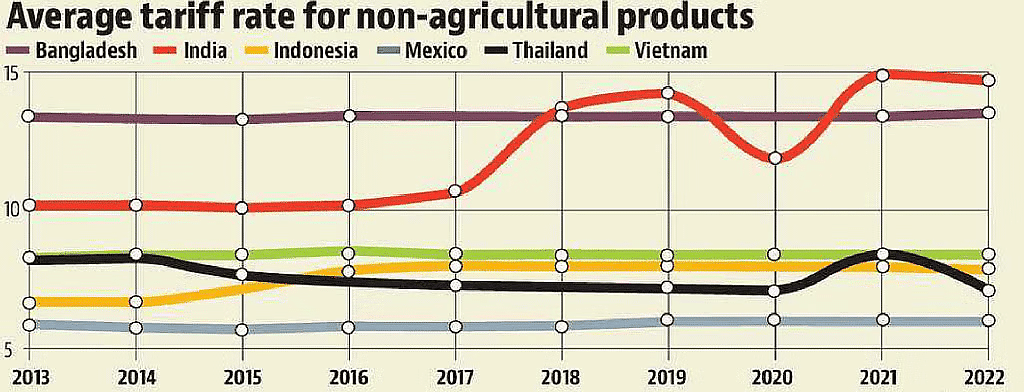

GS3/Environment
UNEP Foresight Report 2024
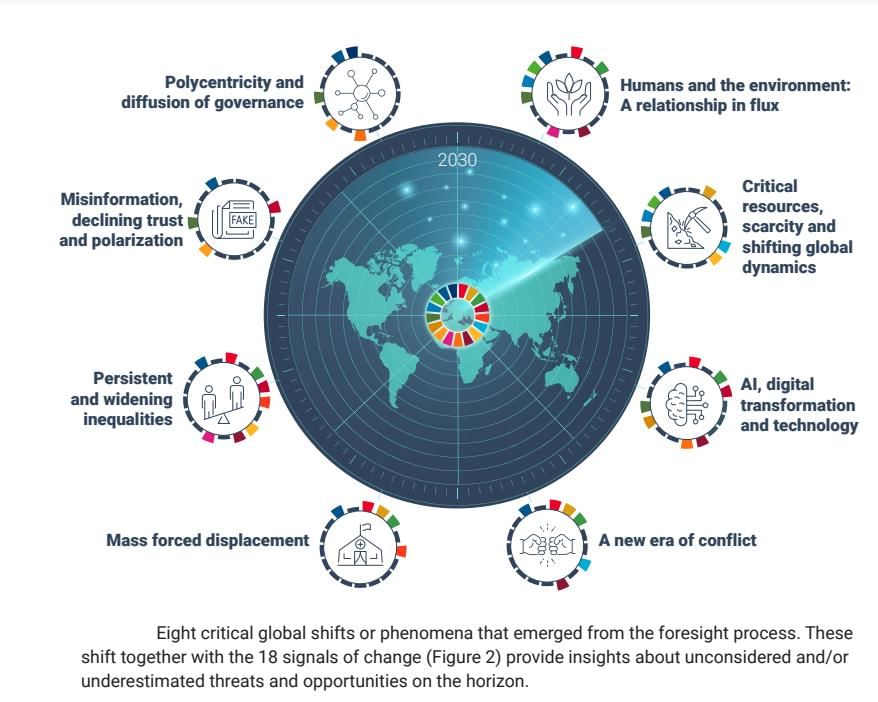 Why in News?
Why in News?
- Recently, the United Nations Environment Programme (UNEP) released a report titled "Navigating New Horizons: A Global Foresight Report on Planetary Health and Human Wellbeing, 2024." The report urges the world to address emerging challenges that could disrupt planetary health. It highlights 8 critical global shifts accelerating the triple planetary crisis of climate change, biodiversity loss, nature loss, and pollution.
Key Highlights of the Report
- No Significant Progress in UN SDG Goals: 85% of the 169 targets are off track. 37% of the targets have shown no progress or have regressed since 2015, as of the latest 2023 SDG Progress Report.
- 42.85% of the targets for SDG 6 (Clean Water and Sanitation), SDG 13 (Climate Action), SDG 14 (Life Below Water) SDG 15 (Life on Land) are either stagnating or regressing.
- 60% of environmental indicators remain either deteriorating or unclear in their status.
8 Shifts, 18 Signals of Change:
- The UNEP report identified 8 critical shifts with potential signals of change. These signals are not inherently good or bad, but are early signs of potential future developments and could have a big impact on the future if they do happen.
Rapidly Changing Relationship Between Humans and Environment:
- Human activities are predicted to affect over 90% of land by 2050. Up to 46% of species may face extinction.
- Global temperatures are projected to rise 2.1-3.9°C by 2100. Greenhouse gas emissions, mainly from fossil fuels, are driving these changes, with developed nations responsible for most emissions.
Scarcity and Competition for Critical Resources:
- The global competition for critical resources is reshaping international security. Demand outpaces supply, amplifying volatility and potential conflicts, especially in regions with concentrated reserves.
- The most fundamental resources, water and food, face growing threats from climate change and unsustainable management, disproportionately affecting vulnerable populations.
AI, Digital Transformation and Technology:
- The key drivers of rapid advancement of digital technologies and AI include mobile devices, internet access, and the growth of technologies that offer prospects for progress; their environmental implications require consideration.
- There are over 8.89 billion mobile subscriptions, with around 5.6 billion users owning a device. As per ITU reports, 67.4% of the world's population were internet users in 2023.
A New Era of Conflict:
- The report warns that AI-based and autonomous weapons could cause major global disruptions in 4-6 years without human oversight.
- Examples include the Ukrainian military using AI-equipped drones to strike Russian targets in the Russia-Ukraine war, posing a risk of AI-controlled bioweapons.
Mass Forced Displacement:
- The report reveals that 1.5% of the global population is forcibly displaced, nearly double the number from a decade ago.
- Climate change is a major driver, with extreme conditions like wildfires, flooding, poor air quality, and intolerable heat contributing significantly.
Widening Inequalities:
- The report highlighted that global inequality is worsening, with the top 10% holding over 75% of wealth, while the bottom 50% own just 2%.
- Inequality within nations is driven by unequal access to education, jobs, and services, as well as globalization. Wealth inequality also leads to ecological inequities, as the wealthy drive climate change, while the poor face the greatest environmental harm.
Misinformation, Declining Trust and Polarisation:
- The erosion of trust in science and public institutions has undermined evidence-based policymaking and democratic governance.
- This decline in trust, from perceived failures and 'fake news', makes it harder to implement effective policies to address challenges like the climate crisis.
Future Outlook and Recommendations of UNEP:
- Broadening Stakeholder Engagement: Actively involve a diverse range of stakeholders, including women, indigenous groups, and young people, using technological and social innovations to enhance public participation, combat misinformation, and build trust.
- Stronger Voice for Young People: Ensure young people have a significant role in decision-making at all governance levels to achieve intra- and inter-generational equity.
- Redefining Progress Beyond GDP: Incorporate broader indicators of human and environmental well-being, such as the Inclusive Wealth Index and Multidimensional Vulnerability Index, to guide investments towards Sustainable Development Goals.
- Community Empowerment: Promote agile and adaptive governance that empowers communities to experiment, innovate, and share knowledge, while setting flexible long-term environmental goals and targets.
- Data-Driven Decision-Making: Leverage data, monitoring, and knowledge-sharing platforms to inform evidence-based policymaking across sectors and scales, enhancing environmental monitoring from local to global levels.
- Sustainable Prosperity: Transform economies and societies to achieve prosperity within environmental limits, guided by shared values of equity, sustainability, and resilience, and reimagine the role of businesses, markets, and governance to prioritize people and the planet.
What is UNEP?
- The UNEP is a leading global environmental authority established in June 1972. It sets the global environmental agenda, promotes sustainable development within the system, and serves as an authoritative advocate for global environment protection.
Major Reports

Major Campaigns
- Beat Pollution
- UN75
- World Environment Day
- Wild for Life
Headquarters
- Nairobi, Kenya
Mains Question:
How has the evolving human-environment relationship impacted global SDG progress? Analyze the implications of this relationship for global progress and propose innovative strategies for a sustainable future.
GS2/Polity
Shadow Cabinets in Parliamentary Democracies
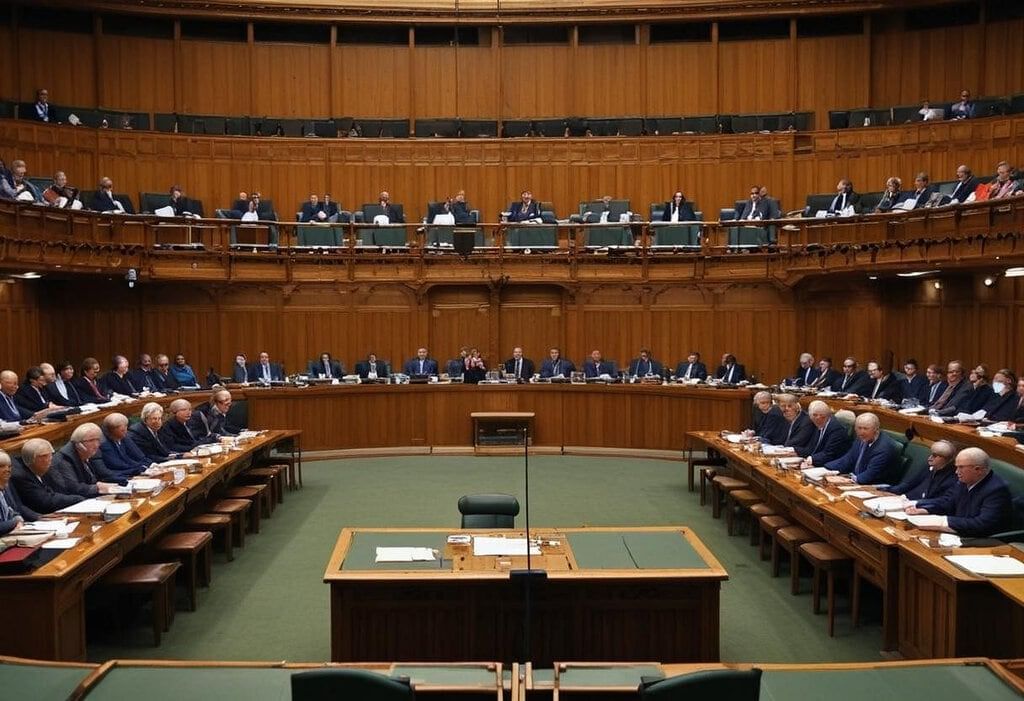 Why in news?
Why in news?
Recently, the leader of the Opposition (LoP) and president of Biju Janata Dal (BJD), has formed a 'shadow cabinet comprising 50 BJD Members of the Legislative Assembly (MLAs) in Odisha. This development comes in the wake of the Bharatiya Janata Party's recent electoral successes in the state and marks a significant shift in legislative dynamics.
What is a Shadow Cabinet?
- About:
- A shadow cabinet consists of opposition MLAs/MPs who mirror the portfolios of government ministers. Led by the LoP, the shadow cabinet monitors and critiques the actions of the ruling government across various departments and ministries.
- In parliamentary democracies around the world, the concept of a shadow cabinet plays a pivotal role in the dynamics of governance and opposition.
Origin and Significance
- Originating from the Westminster system and prominently used in countries like the United Kingdom, Australia, Canada, and New Zealand, the concept of a shadow cabinet offers a structured framework for opposition MPs to scrutinize and challenge the policies of the ruling government.
Benefits
- By shadowing specific ministries, MPs gain in-depth knowledge and expertise, enabling them to effectively challenge government policies during parliamentary debates.
- It provides an opportunity for opposition MPs to gain leadership experience, preparing them for future ministerial roles based on their performance in the shadow cabinet.
- Strengthens parliamentary democracy by ensuring robust scrutiny of executive actions and fostering informed debates on public policies.
Challenges and Criticisms
- In India's multi-party system, coordinating a unified shadow cabinet poses challenges due to differing party priorities and ideologies.
- Critics argue that focusing on specific ministries may limit MPs' holistic understanding of governance issues. However, proponents assert that periodic reshuffles within the shadow cabinet can address this concern.
Potential Implications for Indian Democracy
- Institutionalizing a shadow cabinet can fortify parliamentary oversight mechanisms, ensuring that all legislative actions are thoroughly debated and justified.
- By presenting coherent policy alternatives, the shadow cabinet can enhance public trust in parliamentary proceedings, showcasing opposition parties as credible alternatives to governance.
- Encouraging a shift from personality-driven politics to policy-focused debates, a shadow cabinet promotes a more substantive discourse on governance and public policy.
International Examples
- United Kingdom: The Shadow Cabinet is appointed by the Leader of the Opposition to mirror the Government's Cabinet. Each member leads on a specific policy area for their party and questions and challenges their counterpart in the Cabinet, presenting the Official Opposition as an alternative government-in-waiting.
- Canada: The opposition parties form shadow cabinets, groups of opposition MPs, called critics, who are responsible for the same areas of expertise as the governing party's Cabinet ministers. Having them sit in a mirror image of each other is a reminder that one side can potentially replace the other at any time.
Way Forward
- Formalization: While not mandated by law, the Parliament could amend its rules to formally recognize the LoP and grant them the right to appoint a shadow cabinet. This would elevate the status of the opposition and provide a framework for their operations.
- In the long term, consider amending the Constitution to formally recognize the Leader of the Opposition and the shadow cabinet.
- Research Funding: Parliament could allocate a budget for research staff and resources specifically for the shadow cabinet. This would empower them to analyze government policies more effectively and develop informed alternatives.
- Selection of Shadow Ministers: The LoP should appoint shadow ministers based on their expertise, experience, and qualifications in relevant policy areas. This ensures that the shadow cabinet is composed of individuals capable of providing informed and constructive criticism.
Mains Question:
- Q. Discuss the concept of a shadow cabinet and its role in parliamentary democracies. How does it function as an alternative to the ruling government's cabinet?
GS3/Science and Technology
DPDP Act 2023 and the Issue of Parental Consent

Why in news?
- Recently, the Digital Personal Data Protection Act (DPDPA) 2023 has been welcomed by the industry for its clear compliance structure. However, the provision necessitating verifiable parental consent for processing children's data has caused a divide between industry and government.
Salient Features of the Digital Personal Data Protection Act (DPDPA) 2023
- Right to Data Protection: Individuals are empowered with rights to access, correct, and erase their personal data, granting them more control over their information.
- Data Processing and Consent: Personal data can only be processed with explicit consent, requiring clear and specific consent forms from organizations before data collection.
- Data Localisation: Sensitive data must be stored and processed within India to enhance security and facilitate law enforcement.
- Regulatory Authority: The Data Protection Board of India (DPBI) oversees compliance, disputes, and penalties for violations.
- Data Breach Notification: Organizations must promptly notify individuals and the Board of any data breaches, ensuring transparency and swift action.
- Fines and Penalties: Non-compliance incurs stringent penalties to encourage adherence to data protection standards.
Issues with Obtaining Parental Consent
- About: Section 9 of the DPDP Act requires verifiable parental consent for processing children's data. The Act prohibits harmful data processing and ad targeting for minors.
- Challenges: Challenges include age verification, defining harm to children, managing consent revocation, and ensuring compatibility across devices.
- Concerns: The act lacks guidance on age-gating methods, establishing parent-child relationships, and implementing verifiable parental consent.
Likely Solutions and Their Limitations
- Self-Declaration: Companies can allow parents to declare their relationship during account setup, though it relies on honesty without robust verification.
- Two-Factor Authentication (2FA): Implementing 2FA for parental accounts enhances security through additional verification steps.
- Biometric Verification: Using biometrics for parental consent can offer secure and privacy-friendly validation.
- Proxy Consent: Parents could authorize a trusted third party to verify their relationship with the child, like a school or pediatrician.
Mains Question:
- Q. Discuss the challenges and potential solutions in the effective implementation of the Digital Personal Data Protection Act (DPDPA), 2023.
GS2/Polity
Political Representation of Women
Why in news?
- The recent general elections in the United Kingdom showcased a historic 40% representation of women in the House of Commons, underlining the progress made globally in enhancing women's political involvement. In contrast, women's representation in the Indian Parliament remains notably below the global average of 25%.
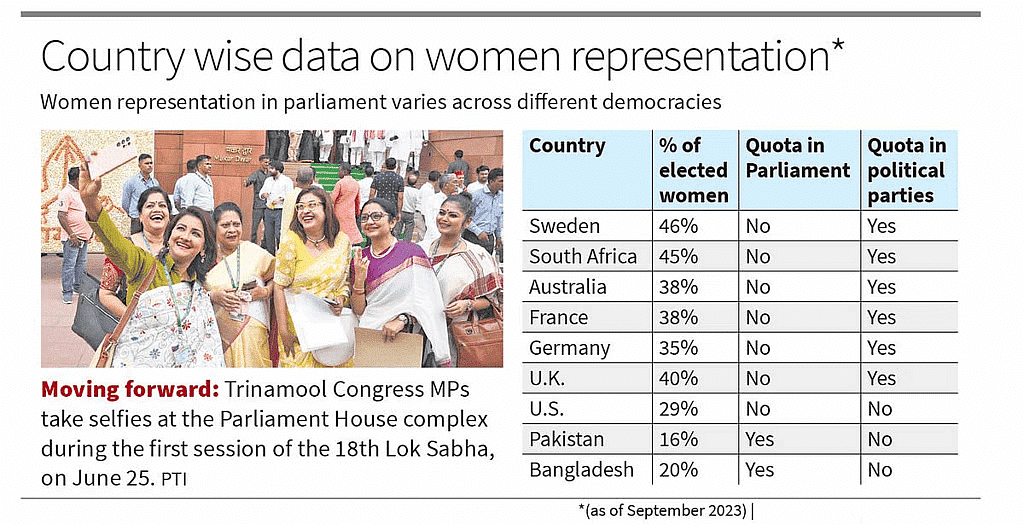
What is the Status of Women's Representation in Indian Parliament?
Women's Representation in Parliament:
- In the Lok Sabha, the percentage of women members has increased from 5-10% until 2004 to 13.6% in the current 18th Lok Sabha, while in the Rajya Sabha, it stands at 13%.
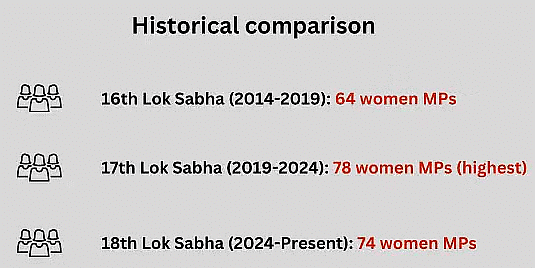
- The number of women contesting elections has shown a gradual rise over the past 15 years. In 2024, there were 799 women candidates contesting the Lok Sabha elections, constituting 9.5% of the total candidates.
- West Bengal leads in electing the most women MPs, with 11 representatives. The Trinamool Congress boasts the highest proportion of women among its Lok Sabha MPs, at 38% in the 18th Lok Sabha.
This is significantly below the national average.
Women's Representation in State Legislatures:
- The national average of women's representation in State Legislative Assemblies remains low, standing at a mere 9%, with no state having more than 20% women legislators.
Global Scenario:
- India ranks 143 among 185 countries in terms of female representation in the lower house of Parliament, lagging behind nations like Sweden (46%), South Africa (45%), the UK (40%), and the US (29%).
India falls behind countries such as Vietnam, the Philippines, Pakistan, and China in terms of gender representation.
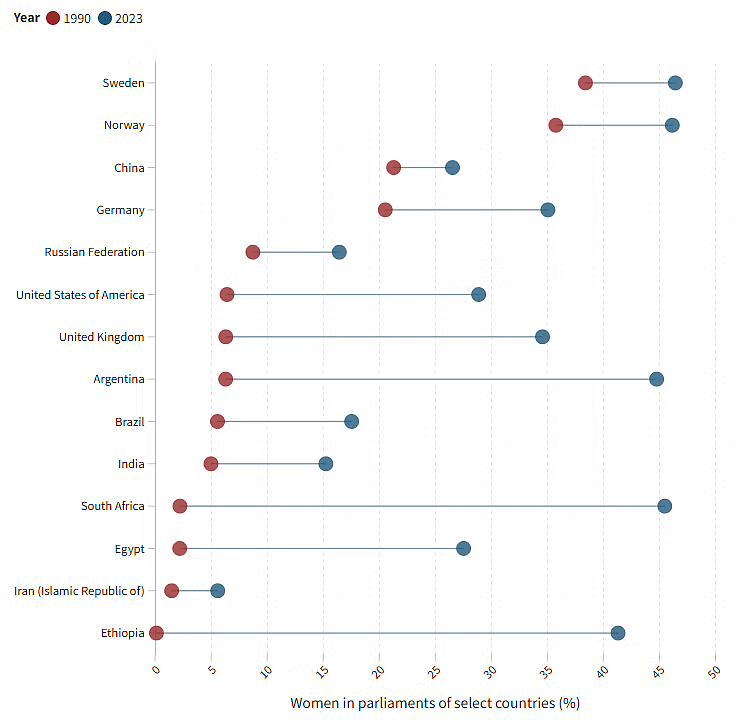
GS3/Economy
Green Revolution in Maize
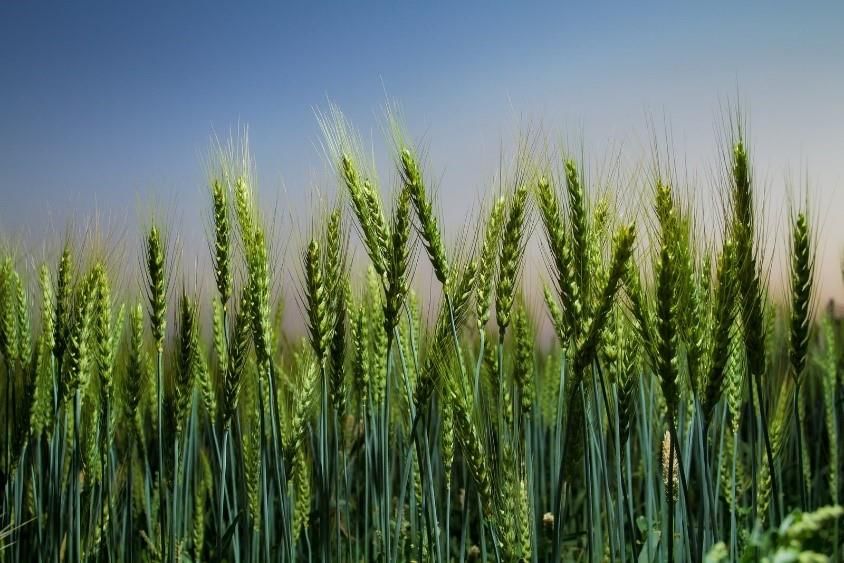 Why in News?
Why in News?
- Recently, India's maize industry has undergone a remarkable transformation, evolving from a basic feed crop to a crucial component in the fuel and industrial sectors. This shift is indicative of a broader green revolution, echoing the historic advances made in wheat and rice but with a modern twist driven largely by private-sector innovations.
What is the Current State of Maize Production in India?
- Tripling Production: Since 1999-2000, India's maize production has more than tripled, increasing from 11.5 million tonnes to over 35 million tonnes annually, with average per-hectare yields also rising from 1.8 to 3.3 tonnes.
- India is the fifth largest maize producer, accounting for 2.59% of global production in 2020.
- Maize is the third most important cereal crop after rice and wheat, accounting for around 10% of total food grain production in the country.
- Yield Improvements: Average per-hectare yields have risen from 1.8 to 3.3 tonnes over the same period.
- Major States: Karnataka, Madhya Pradesh, Bihar, Tamil Nadu, Telangana, Maharashtra, and Andhra Pradesh are the primary maize-growing states.
- Year-Round Cultivation: Maize is grown throughout the year, predominantly as a Kharif crop (85% of the maize cultivation area is during this season).
- Export Volume: India exported 3,453,680.58 MT of maize worth Rs. 8,987.13 crores in 2022-23.
- Major Export Destinations: Bangladesh, Vietnam, Nepal, Malaysia, and Sri Lanka are key markets for Indian maize.
- Major Uses: Approximately 60% of maize is used as feed for poultry and livestock, while only about 20% is directly consumed by humans.
Starch and Ethanol
- Maize grains, containing 68-72% starch, are used in industries such as textiles, paper, and pharmaceuticals.
- Recent developments have shifted focus to using maize for ethanol production, particularly as a substitute for rice in ethanol blending due to food security concerns.
- During the crushing season, distilleries run on sugarcane molasses and juice/syrup, while in the off-season they use grains, with the recent shift towards maize.
How does Maize's Green Revolution Compare to Wheat and Rice?
- Unlike self-pollinating wheat and rice, maize's cross-pollinating nature makes hybrid breeding commercially viable.
- The Green Revolution in maize has been, and continues to be, a private sector-led one.
- Private-sector hybrids dominate over 80% of maize cultivation, with high yields limited to the first generation.
Innovations in Maize Cultivation
- The Indian Agricultural Research Institute (IARI) has bred India's first "waxy" maize hybrid (AQWH-4) with high amylopectin starch content, making it better suited for ethanol production.
Private Sector's Role
- The International Maize and Wheat Improvement Center (CIMMYT) has established a maize doubled haploid (DH) facility in Kunigal (Karnataka), producing high-yielding, genetically pure inbred lines.
Initiatives to Promote Maize in India
- National Food Security Mission (NFSM).
- India Maize Summit: Organized in 2022, with a focus on securing a sustainable maize supply to meet growing demand and increase farmer prosperity.
- Rashtriya Krishi Vikas Yojana (RKVY).
Mains Question:
Q. Discuss the recent transformation of India's maize industry from a basic feed crop to a crucial component in the fuel and industrial sectors.
GS3/Economy
Centralised Hiring in Eklavya Model Residential Schools
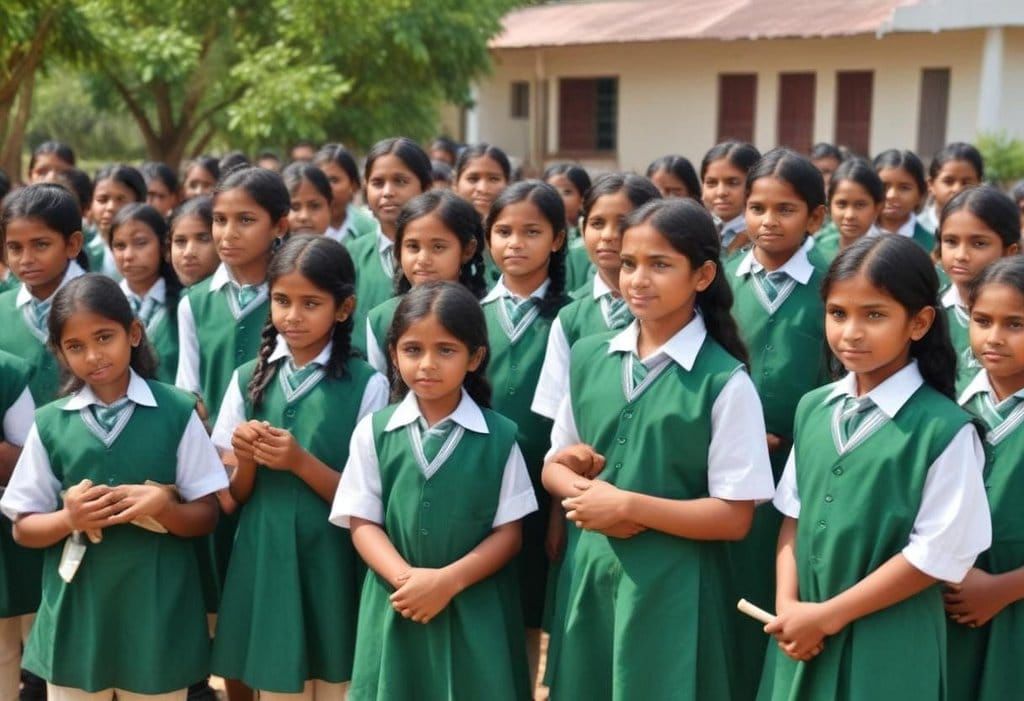 Why in news?
Why in news?
- The centralisation of recruitment for the Eklavya Model Residential Schools (EMRS) across the country (introduced in 2023 Budget), which introduced Hindi competency as a mandatory requirement, has resulted in a request for transfers. Although central officials emphasise that applicants were required to be willing to accept postings anywhere in the country, the larger concern is the potential impact on tribal students being taught by teachers who are unfamiliar with the local language and culture.
What are Eklavya Model Residential Schools (EMRS)?
- EMRS is a scheme for making model residential schools for Indian tribals (ST- Scheduled Tribes) across India.
- It started in the year 1997-98.
- Its nodal ministry is the Ministry of Tribal Affairs.
- These schools are being developed to provide quality education to tribal students, focusing on academic as well as overall development.
- The EMR Schools generally follow the CBSE curriculum.
- The scheme aims to build schools similar to Jawahar Navodaya Vidyalayas and Kendriya Vidyalayas, with a focus on state-of-the-art facilities for preserving local art and culture, as well as providing training in sports and skill development. The EMRS scheme was revamped in FY 2018-19.
Recent Issue Related to Recruitment to EMRS
- Requirement of Hindi Competency: The recent centralization of recruitment introduced Hindi competency as a mandatory requirement. This has resulted in a large number of staff recruited from Hindi-speaking states being posted to EMRS in southern states, where the language, food, and culture are unfamiliar to them. The government has stated that the requirement of basic Hindi language competency is not unusual, as it is mandatory for recruitment as well.
- Impact on Tribal Students: Most tribal students in Eklavya schools would benefit from teachers who understand their local cultural contexts, as the communities have very specific contexts under which learning can be made conducive. Government officials have stated that teacher recruits are expected to learn the local language within two years, but there have been apprehensions among the recruited teachers about learning a new, completely different language. The posting of non-local teachers can negatively impact the learning of tribal students, as they may not be able to adjust to teachers who are not aware of their cultural context.
Way Forward
- Localised Recruitment: Recruitment of teachers from local communities should be prioritised to ensure they are familiar with the cultural and linguistic contexts of the students. Both local and non-local teachers should be recruited to ensure a diversity of teaching methods while respecting local traditions.
- Flexible Language Requirements: The mandatory Hindi competency requirement should be reevaluated to allow for flexibility in non-Hindi speaking regions. Language support programs should be actively encouraged for teachers to learn the local languages of the regions they are posted to.
- Cultural Sensitivity Training: Comprehensive cultural sensitivity training should be provided to all teachers, especially those from non-local areas, to help them understand and integrate into the community they are serving. Develop ongoing professional development programs focusing on local cultural contexts and language skills.
- Policy Review: Regular reviews of the recruitment policy should be conducted to assess its impact on both teachers and students, making necessary adjustments to address emerging issues. Ensure that policies are adaptable to the diverse cultural and linguistic landscapes across different states.
Mains Question:
Q. Discuss the issues related to Eklavya Model Residential Schools (EMRS) and how to solve them?
|
201 videos|1016 docs|2274 tests
|
FAQs on Weekly Current Affairs (15th to 21st July 2024) Part - 2 - General Test Preparation for CUET UG - CUET Commerce
| 1. What is the concept of "China Plus One" in the context of global supply chains? |  |
| 2. What are some factors driving the adoption of the "China Plus One" strategy among companies? |  |
| 3. How can countries benefit from the "China Plus One" strategy in terms of economic development? |  |
| 4. What are some challenges companies may face when implementing the "China Plus One" strategy? |  |
| 5. How can policymakers support and facilitate the transition to a "China Plus One" strategy for companies? |  |
















